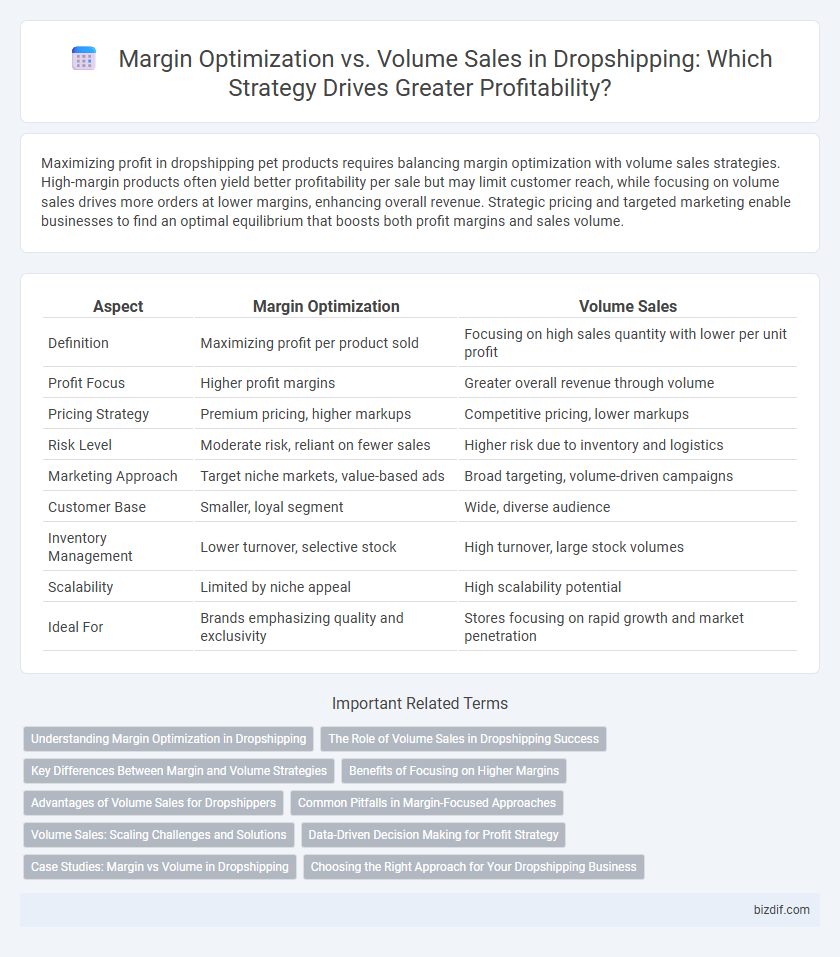Maximizing profit in dropshipping pet products requires balancing margin optimization with volume sales strategies. High-margin products often yield better profitability per sale but may limit customer reach, while focusing on volume sales drives more orders at lower margins, enhancing overall revenue. Strategic pricing and targeted marketing enable businesses to find an optimal equilibrium that boosts both profit margins and sales volume.
Table of Comparison
| Aspect | Margin Optimization | Volume Sales |
|---|---|---|
| Definition | Maximizing profit per product sold | Focusing on high sales quantity with lower per unit profit |
| Profit Focus | Higher profit margins | Greater overall revenue through volume |
| Pricing Strategy | Premium pricing, higher markups | Competitive pricing, lower markups |
| Risk Level | Moderate risk, reliant on fewer sales | Higher risk due to inventory and logistics |
| Marketing Approach | Target niche markets, value-based ads | Broad targeting, volume-driven campaigns |
| Customer Base | Smaller, loyal segment | Wide, diverse audience |
| Inventory Management | Lower turnover, selective stock | High turnover, large stock volumes |
| Scalability | Limited by niche appeal | High scalability potential |
| Ideal For | Brands emphasizing quality and exclusivity | Stores focusing on rapid growth and market penetration |
Understanding Margin Optimization in Dropshipping
Margin optimization in dropshipping focuses on maximizing profit per sale by carefully selecting high-margin products and minimizing costs such as shipping and supplier fees. This strategy prioritizes quality over quantity, ensuring sustainable profitability without relying on high sales volume. Leveraging data analytics to monitor pricing trends and supplier performance can significantly enhance margin optimization outcomes.
The Role of Volume Sales in Dropshipping Success
Volume sales play a critical role in dropshipping success by generating consistent cash flow and amplifying profit margins through economies of scale. Higher sales volumes allow dropshippers to negotiate better rates with suppliers, reduce per-unit costs, and leverage marketing investments more efficiently. While margin optimization remains important, prioritizing volume drives sustainable growth and competitive advantage in the dropshipping marketplace.
Key Differences Between Margin and Volume Strategies
Margin optimization in dropshipping focuses on increasing the profit per sale by selecting high-margin products and minimizing costs, while volume sales strategies prioritize boosting the total number of sales to generate revenue through higher throughput. Margin strategies emphasize product pricing, supplier negotiation, and efficient operations to maximize profitability on each unit sold. Volume sales rely on marketing scalability, competitive pricing, and broad market reach to drive large sales volumes despite thinner profit margins.
Benefits of Focusing on Higher Margins
Focusing on higher margins in dropshipping enhances profitability per transaction, allowing for sustainable business growth without relying solely on high sales volume. Higher margins provide flexibility for marketing investments and absorb operational costs, improving cash flow and financial stability. This strategy reduces dependency on rapid inventory turnover, minimizing risks associated with stock shortages and price wars.
Advantages of Volume Sales for Dropshippers
Volume sales in dropshipping enable significant revenue growth by leveraging economies of scale to reduce per-unit costs and increase overall profitability. High sales volume enhances supplier relationships, resulting in better pricing, faster shipping, and priority access to trending products. Moreover, consistent large orders improve marketplace visibility and customer trust, boosting long-term brand recognition and repeat business.
Common Pitfalls in Margin-Focused Approaches
Focusing solely on margin optimization in dropshipping can lead to underestimating customer acquisition costs and reducing overall sales volume, which may hurt long-term profitability. Common pitfalls include setting prices too high, resulting in lower conversion rates and limited market reach. Balancing margins with competitive pricing strategies is essential to avoid inventory stagnation and maximize revenue growth.
Volume Sales: Scaling Challenges and Solutions
Volume sales in dropshipping face scaling challenges such as inventory management complexities, supplier reliability issues, and increased operational costs. Effective automation tools, real-time data analytics, and diversified supplier networks help streamline order processing and reduce delays. Prioritizing customer experience through fast shipping and responsive support also mitigates high return rates and maintains sale momentum.
Data-Driven Decision Making for Profit Strategy
Margin optimization in dropshipping centers on maximizing profit per unit by analyzing product costs, pricing strategies, and supplier fees, leveraging data-driven insights to identify high-margin items. Volume sales emphasize increasing order quantity through competitive pricing and marketing analytics, utilizing conversion rates and customer acquisition costs to drive revenue growth. Data-driven decision making integrates metrics like average order value, profit margins, and sales velocity to balance margin optimization with volume sales, enhancing overall dropshipping profit strategy.
Case Studies: Margin vs Volume in Dropshipping
Case studies in dropshipping reveal that margin optimization often yields higher profitability per transaction by targeting premium products with exclusive suppliers and strategic pricing models. Alternatively, volume sales focus on scaling lower-margin items through aggressive marketing and broad audience reach, which can lead to significant revenue growth but thinner profit margins. Successful dropshipping businesses balance these strategies by analyzing customer data and supply chain efficiencies to maximize overall profit while sustaining competitive pricing.
Choosing the Right Approach for Your Dropshipping Business
Margin optimization in dropshipping emphasizes high-profit products with lower sales volume, maximizing revenue per order and enhancing overall profitability. Volume sales focus on selling large quantities of lower-margin items to generate substantial cumulative income and market presence. Selecting the right approach depends on product niche, target audience, supplier reliability, and cash flow requirements, ensuring sustainable growth and competitive advantage.
Margin Optimization vs Volume Sales Infographic

 bizdif.com
bizdif.com